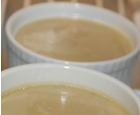|
Caribbean Dessert Coffee Cream Custard A smooth, rich coffee flavored custard that's topped with whipped cream. Absolutely yummy.
Take a spoonful of the warm custard mixture and add it to the well-beaten eggs, stirring rapidly to incorporate (make sure liquid isn't too hot so as to cook the eggs). Add egg mix back into the main custard, stirring till thoroughly mixed. Continue to cook over simmering heat 2-3 more minutes, stirring constantly. Remove from heat, cool slightly, and pour into individual custard cups. Chill several hours till firm, top with whipped cream, and serve.
|
Tips & Glossary Caribbean cuisine is an exquisite blend of African, Asian, European, and Carib Indian (the area's original inhabitants) foods. Dishes are highly seasoned, either with a dry rub or marinade —or both. Below are some typical ingredients found in Caribbean food. Callaloo: young leaves of either the taro root plant or amaranth; used widely in Caribbean cooking. Spinach can be used as a substitute. Spices: Allspice, bay leaves, black pepper, chives, chili peppers, cilantro, cinnamon, coconut, curry powder, escallion, garlic, ginger, lime, mace, nutmeg, onion, oregano, sugar, thyme, orange, tomato paste, vanilla, cayenne (red) pepper. Jerk: Jamaican cooking method in which meat is rubbed, prior to grilling, with a blend of seasonings, often firey hot. • 1 T each—onion powder, garlic powder, dried chives, brown sugar; 2 tsp. each— (ground) allspice, nutmeg, cinnamon; 1 tsp. each—sage. thyme, salt, black pepper, cayenne (or more to taste). Mix thoroughly and store in a tightly covered jar. There are thousands of versions; figure out what flavors you like most and add or subtract accordingly. Typical meats: goat, pork, chicken, and some beef (though beef has tended to be expensive). Fish: varieties that abound in surrounding waters, some familiar to us—grouper, cod, tilapia, blue marlin; others not so—200 species of jack, chip-chips (tiny clams), casadura (primitive armored catfish). Native plant foods: More familiar foods:
|

